The summer after my freshman year of college, I took a trip to Northern Minnesota. Amongst the lush green, I decided to give Joni Mitchell’s “Blue” a try. Being a child of the booming stadium pop of the early to mid 2010’s, “Blue” sounded nothing like the kind of music I’d grown to love. With Janet Jackson’s 1997 single “Got Til It’s Gone,” which sampled Mitchell’s “Big Yellow Taxi,” being my only previously known exposure to Mitchell’s work, I immersed myself into the album despite my initial apprehension of her distinct voice and acoustic sound. “Blue’s” detailed exploration of life after heartbreak went against everything that contemporary popular music taught me.
After several more listens, and allowing the album to soundtrack my mid-July strolls along the pebble-filled beaches of Grand Marais, Mitchell’s words began to permeate my consciousness and started to leave a deeper impression on my temporal lobe. Soon enough, I felt compelled to join in on Mitchell’s wallowing in “some dark cafe” that I might pass on the drive through the quaint town.
My introduction to Mitchell’s music is not singular. Love for her music has spread throughout Millennial and Gen Z demographics in recent years, in effect continuing to establish her influence nearly two decades since her last studio release. Whether it be further exploring her catalog after hearing “River” play around the house while growing up, or being drawn to the startlingly raw lyrics on “Blue,” new listeners have reestablished Mitchell and her music as a mainstay in the collective consciousness of popular music.
Mitchell’s artistic brilliance is best captured by her work done throughout the 1970’s. Almost all of her releases from the decade have found their way onto various “best of” lists from a number of publications, but 1970’s “Ladies of the Canyon,” 1971’s “Blue” and 1974’s “Court and Spark” collectively represent the true essence of her brilliance.
In many ways, Mitchell’s music is the antithesis of contemporary popular music that fills the radio and circulates on social platforms today. But even in her heyday of popularity, Mitchell’s music often struggled to be understood. Her work was never aimed to be a commercial smash, but was rather created out of an incessant need to produce something worthwhile from life’s beauty and misery.
Mitchell was not like the Fleetwood Mac’s of her time — she had few “hits,” and to this day has only had nine songs chart on the Billboard Hot 100, with only one cracking the top 10.
“‘Adult contemporary’ wouldn’t have me, ‘pop’ wouldn’t have me, so for twenty years I did not ‘fit,’” she told Details in 1996.
“But I’m a musical explorer and not just a pop songwriter or an occasional writer of a song or half a song.”
While some peers such as David Crosby lauded her work, critics and consumers alike often fixated on her personal life and sought to point fingers at her for being a hopeless romantic.
“‘Blue’ really was a turning point in a lot of ways,” Mitchell told Rolling Stone in 1979. “I perceived my inability to love at that point. And it horrified me.”
Mitchell was repeatedly chastised for her romantic misfortunes, which clouded the reception to her work as well. One diagram published in Rolling Stone in particular reduced her identity to her romantic partners.
“It was an easy target to slam me for my romantic alliances,” she added. “That hurt, but not nearly so much as when they began to tear apart ‘The Hissing of Summer Lawns.’”
Mitchell was 27 years old when “Blue” was released. The personal and emotional changes that come along with being a twentysomething are often startlingly uncomfortable, and her work throughout the ‘70s, and most notably on “Blue,” captured stories from that uncertain time in Mitchell’s own life.
To this day, when silence is too bleak but I’m in need of some solace, I turn to Mitchell’s music. 1971’s “A Case of You” and “The Last Time I Saw Richard” continue to resonate just as deeply as the first time I heard them. The jazzy chords of 1976’s “Coyote” wipe away my senses of the present and allow for five minutes of uninterrupted reflection of my surroundings. Her work has often taught me how to notice more of the life happening around me as I navigate my early adulthood, and to see the smallest moments and interactions as beautiful. Since beginning my journey with her music, I’ve also become much more aware of the talent it takes to turn simple, straightforward lyrics into lines that cut deep. Her music has taught me the importance of the age-old saying “less is more,” and has proved to me that sometimes the most profound art comes from the most simple ideas.
“The ‘Blue’ album, there’s hardly a dishonest note in the vocals. At that period of my life, I had no personal defenses,” she told Rolling Stone in the same 1979 interview. “I felt like a cellophane wrapper on a pack of cigarettes. I felt like I had absolutely no secrets from the world and I couldn’t pretend in my life to be strong
Though written as sometimes hyper-specific recounts of relationships, Mitchell’s work maintains an element of ubiquity that’s easily applied to the experiences of people’s lives even half a century later. To the lonely young adult struggling to face the inevitable changes that come with adulthood, songs like “The Last Time I Saw Richard” cut deep. For the listener who’s faced with moving across the country to start over, “Refuge of the Roads” offers solace within a “highway service station.”
Mitchell’s personal mystique also likely adds to her resurgence in recent years. At 80 years old, so much remains unknown about her beyond her music, which prompts young listeners to be insatiably curious to uncover the person depicted in her songs.
In 1993, Mitchell’s former art school roommate revealed that the singer had given birth to a child in the mid-’60s and put them up for adoption. Mitchell wrote the song “Little Green,” from 1971’s “Blue,” about the grief she experienced after giving her daughter up for adoption, but the world didn’t know of the autobiographical nature of the song until over 20 years after its release. The lyrics of “Little Green” read pointed and daringly honest today, but somehow maintained a strong enough sense of elusivity to inadvertently protect Mitchell’s privacy. Her use of staggeringly honest lyrics allow her to reveal her thoughts and reactions to life experiences without the need to specify the exact subject of the song. This practice that she’s utilized throughout her career is part of what continues to speak to people, and has maintained listeners’ devotion to her.
The music from the “golden era” of Mitchell’s career blurs the line between being relatable and aspirational. Especially for those who are now similar in age to Mitchell’s own when she released such pioneering work, her tales of being a hopeless romantic remain comforting.
This quality of being both relatable and aspiration has influenced countless artists that have come after Mitchell’s heyday as well. Björk, Taylor Swift and even Olivia Rodrigo have all credited Mitchell and her music as an inspiration for their own work. Swift’s pandemic-era album “folklore” in particular took after Mitchell’s signature acoustic sound and visual lyricism. Lana Del Rey’s lyrical style is closely similar to Mitchell’s own practice of romanticization of small details. But Mitchell’s influence stretches far beyond these few mainstream pop acts — music legends such as Bob Dylan, Chaka Khan and Prince have all lauded her work over the years.
Mitchell’s sound continues to transcend space and time, speaking to anyone who takes enough time to let the music wash over them. The warm guitar chords of “Help Me” address the fear that comes with falling for someone, while “My Old Man” professes passion for one’s “sunshine in the morning.” “A Case of You” depicts a relationship that has run its course but leaves its maddening imprint on one’s soul, and “The Circle Game” broadens the scope of Mitchell’s romantic subject matter, capturing how we choose to spend our lives with the time we’re given. For every hyper-specific experience one goes through — especially as a young adult — there’s a Mitchell song to accompany.
















